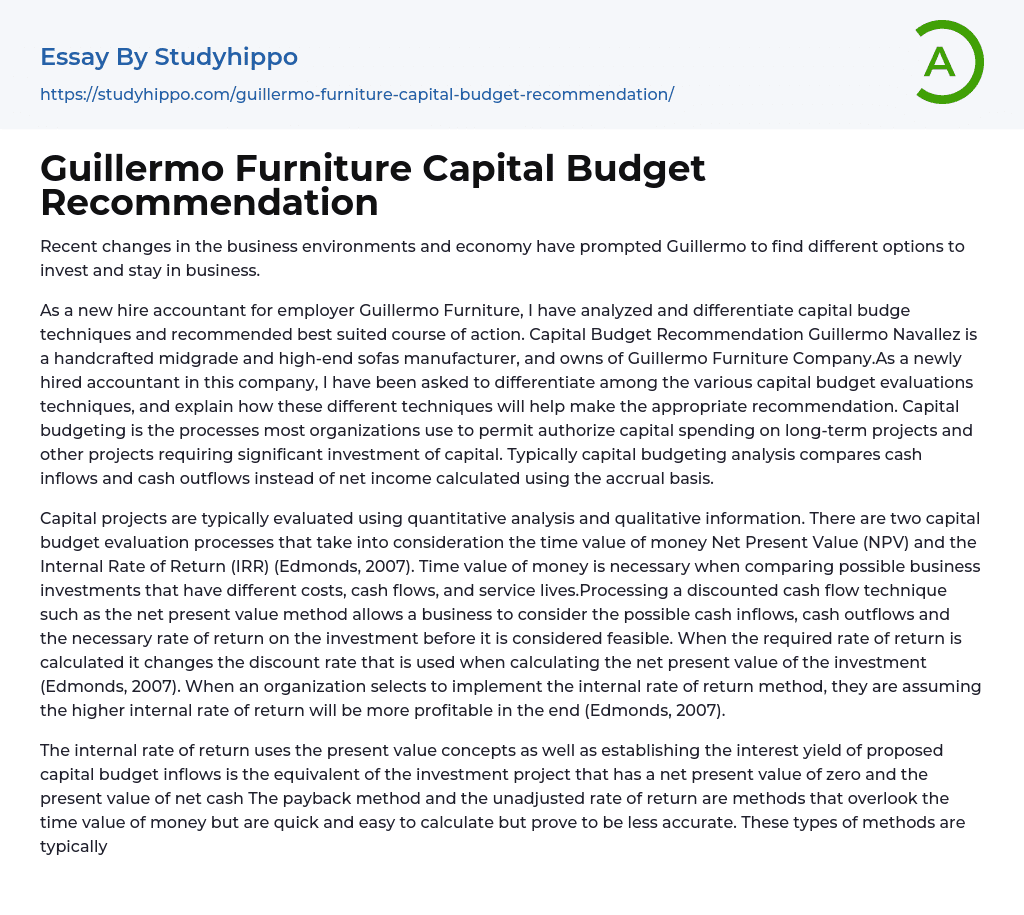As a recent hire at employer Guillermo Furniture, I have analyzed and distinguished between various capital budgeting techniques and recommended an appropriate course of action. Guillermo Navallez is the proprietor of Guillermo Furniture Company, which specializes in crafting high-end and midgrade sofas. In my capacity as an accountant for the corporation, I have been tasked with differentiating between several capital budgeting techniques and explaining how using different methods can inform proper recommendations. Capital budgeting is an integral process that most entities use to authorize spending on long-term investments and other high-cost projects that necessitate substantial financial resources. Generally, capital budgeting analysis involves comparing cash inflows to cash outflows inst
...ead of using accrual basis accounting to compute net income.
Capital projects are typically evaluated through both quantitative analysis and qualitative information. Two evaluation processes used to consider the time value of money are the Net Present Value (NPV) and Internal Rate of Return (IRR) techniques (Edmonds, 2007). The time value of money is essential for comparing business investments that differ in cost, cash flows, and service lives. Discounted cash flow techniques, like the NPV method, allow businesses to analyze possible cash inflows, outflows, and required rates of return before determining feasibility. Calculating the required rate of return alters the discount rate used in NPV calculations (Edmonds, 2007). Organizations that opt for the IRR method believe that selecting a higher internal rate of return ultimately makes investments more profitable (Edmonds, 2007).
The internal rate of return uses present value concepts to determine the interest yield o
proposed capital budget inflows. It searches for an investment project with a net present value of zero and present value of net cash. Although the payback method and unadjusted rate of return disregard the time value of money, they are quicker and easier to calculate, making them ideal for smaller investments. The payback method calculates the time needed to recover initial investment costs and recommends a shorter payback period. To determine the payback period, use this formula: Payback Period = Net cost of investment ? Annual net cash inflow. Another non-discounted cash flow technique is the unadjusted rate of return or simple rate of return for capital budgeting.
The calculation of investment cash flows involves using the simple rate of return method, which disregards the time value of money. The unadjusted rate of return is obtained by dividing the average increase in annual net income by the original investment's net cost. To determine a project's net present value, subtract its cost from the present value of its cash flows. A negative outcome indicates that the expected present value of cash flows is lower than the investment's cost, thereby leading to rejection or adjustment through investing at a required rate. Conversely, positive net present values indicate that implementing projected investments and generating cash flow would be more beneficial compared to investing at a standard rate of return.
In order to determine the net present value, it is necessary to identify both the cash inflows and outflows as well as the required rate of return on the investment (Edmonds, 2007). For projects that are already in progress, the internal rate of return method can be utilized to recreate a
cash flow that matches the project's cost. Typically, more profitable investments will have a higher internal rate of return. To calculate IRR, simply divide the proposed investment by net annual cash flow in order to generate an internal rate of return factor. This factor can then be used to find the present value of an annuity of 1 table which takes into account both project service life and number of periods.
The internal rate of return is the discount rate closest to the factor, according to Edmonds in 2007. The payback method calculates the time needed for a company to recover its initial investment in cash. However, this approach has a major drawback as it neglects any future cash flows and the salvage value of purchased assets. On the other hand, the discounted payback period technique considers discounted cash flows that have been discounted to their present value and is similar to payback period in measuring the investment recovery time.
Guillermo Furniture is facing competition and needs to alter production methods. After examining financial data on Hi-Tech and Distribution options, it is clear that Hi-Tech furniture production should be pursued. Despite revenue increases being similar in both options, switching to Hi-Tech can result in a 353% profit increase. The attached excel worksheet provides a breakdown of this calculation. (CliffsNotes).
According to (com), investing in hi tech is a favorable option for Guillermo furniture as it has a positive net present value and an impressive internal rate of return of 0.998. Therefore, it is highly recommended to consider investing in hi tech.
After careful analysis of financial data and implementation of key capital budgeting techniques, it is recommended that Guillermo
Furniture invests in hi-tech furniture manufacturing as a means of surviving in a highly competitive marketplace.
- Asset essays
- Capital market essays
- Day Trading essays
- Depreciation essays
- Discounted Cash Flow essays
- Foreign Direct Investment essays
- Funds essays
- Futures Trading essays
- Internal Rate Of Return essays
- Million essays
- Revenue essays
- Income Statement essays
- Net Present Value essays
- Funding essays
- Hedge Fund essays
- Payment essays
- Rate Of Return essays




